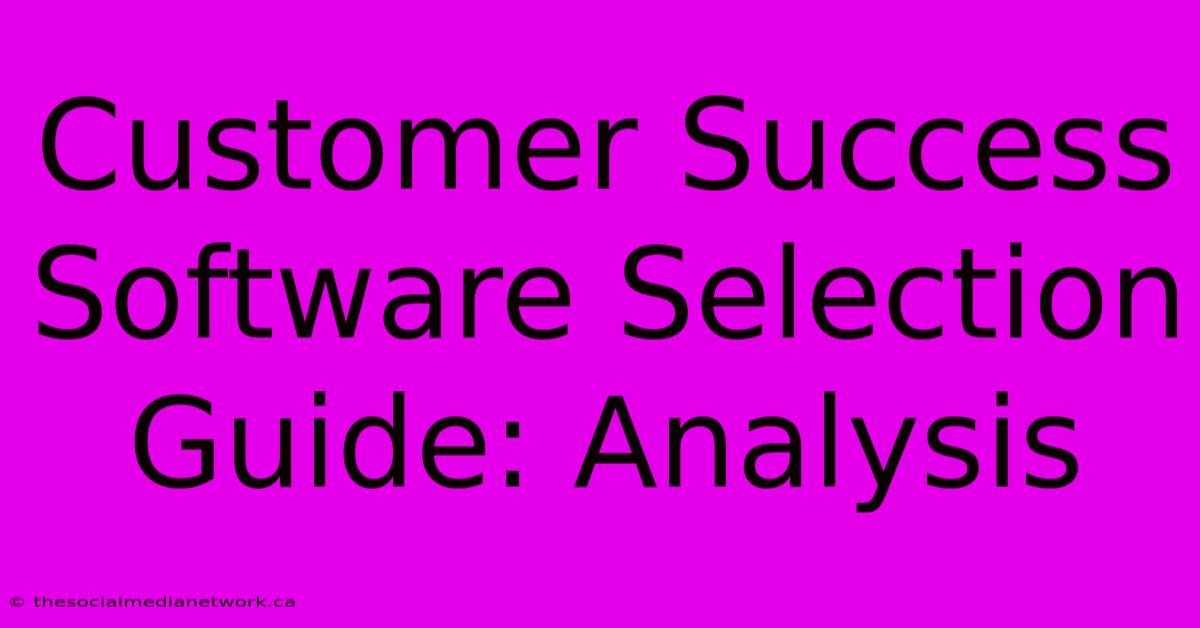Customer Success Software Selection Guide: Analysis

Discover more detailed and exciting information on our website. Click the link below to start your adventure: Visit Best Website meltwatermedia.ca. Don't miss out!
Table of Contents
Customer Success Software Selection Guide: A Deep Dive Analysis
Choosing the right Customer Success (CS) software can feel like navigating a minefield. With so many options promising similar features, how do you select the platform that truly aligns with your business needs and drives growth? This comprehensive guide provides a detailed analysis to help you make an informed decision. We'll dissect key factors, explore different software types, and offer a structured approach to your selection process.
Understanding Your Customer Success Needs:
Before diving into specific software, it's crucial to understand your current challenges and future goals. Ask yourself these critical questions:
- What are your key customer success metrics? (e.g., churn rate, customer lifetime value, Net Promoter Score (NPS)) Defining these upfront helps you identify the software features that will directly impact them.
- What are your biggest pain points in managing customer relationships? Are you struggling with communication, onboarding, or tracking key metrics?
- What is your budget for CS software? Pricing models vary widely, from subscription-based to tiered plans. Establish a clear budget early in the process.
- What is your team's technical proficiency? Some platforms are more user-friendly than others. Choose a solution that aligns with your team's capabilities.
- What is the size and complexity of your customer base? A solution that works for a small business might not scale effectively for a large enterprise.
Types of Customer Success Software:
The market offers a range of software solutions, each with its own strengths and weaknesses. The most common types include:
- Customer Relationship Management (CRM) systems with CS capabilities: Salesforce, HubSpot, and Zoho CRM often include features like case management, reporting, and communication tools. These are good starting points if you're already using a CRM and need to expand its CS functionality.
- Dedicated Customer Success Platforms: These platforms are built specifically for CS teams and offer more advanced features like health scoring, customer journey mapping, and proactive intervention capabilities. Examples include Gainsight, Totango, and ChurnZero.
- Support Ticketing Systems with CS Integrations: While primarily focused on support, platforms like Zendesk and Freshdesk can integrate with other tools to offer basic CS features. These are best suited for organizations with simpler CS needs.
Key Features to Consider:
When comparing different software options, prioritize the following features:
- Customer Segmentation & Health Scoring: The ability to segment customers based on various criteria (e.g., engagement, usage, revenue) and assign health scores is crucial for prioritizing your efforts.
- Proactive Engagement Capabilities: Tools that allow you to proactively identify at-risk customers and intervene early are essential for reducing churn.
- Communication & Collaboration Tools: Seamless communication channels (email, in-app messaging, etc.) and collaboration features within the platform are crucial for effective teamwork.
- Reporting & Analytics: Comprehensive dashboards that provide clear insights into key CS metrics are vital for tracking progress and making data-driven decisions. Real-time dashboards are especially valuable.
- Integration Capabilities: Ensure the software integrates smoothly with your existing systems (CRM, marketing automation, etc.) to avoid data silos and improve efficiency.
Real-Life Example:
Imagine a SaaS company experiencing high churn rates. By implementing a dedicated CS platform with health scoring capabilities, they can identify at-risk customers early based on usage patterns and proactively reach out with personalized support and onboarding improvements. This proactive approach significantly reduces churn and improves customer lifetime value.
The Selection Process: A Step-by-Step Guide:
- Define Requirements: Clearly articulate your needs and goals.
- Research & Shortlist: Identify potential solutions based on your requirements.
- Request Demos: Schedule demos with shortlisted vendors to see the software in action.
- Trial & Evaluation: If possible, request a free trial to test the software in your environment.
- Compare & Contrast: Create a comparison chart to weigh the pros and cons of each solution.
- Make Your Decision: Select the platform that best meets your needs and budget.
FAQ:
- Q: What is the average cost of Customer Success software? A: Pricing varies significantly based on features, the number of users, and the vendor. Expect to pay anywhere from a few hundred dollars to thousands of dollars per month.
- Q: Can I integrate my existing CRM with a new CS platform? A: Most modern CS platforms offer integration capabilities with popular CRMs. However, always verify compatibility before making a purchase.
- Q: How long does it typically take to implement Customer Success software? A: Implementation time varies depending on the complexity of the platform and your organization's size and processes. Expect anywhere from a few weeks to several months.
- Q: What metrics should I track after implementing CS software? A: Focus on key metrics like customer churn rate, customer lifetime value (CLTV), customer satisfaction (CSAT), and Net Promoter Score (NPS).
By following this comprehensive guide and carefully considering your unique needs, you can select the Customer Success software that empowers your team to drive growth and build lasting customer relationships. Remember, the right platform is an investment in your future success.

Thank you for visiting our website wich cover about Customer Success Software Selection Guide: Analysis. We hope the information provided has been useful to you. Feel free to contact us if you have any questions or need further assistance. See you next time and dont miss to bookmark.
Featured Posts
-
Engagement Solutions Market
Dec 02, 2024
-
Food And Beverage E Commerce 2024 2033 Outlook
Dec 02, 2024
-
World Bowls Tongas Nathan Triumphs
Dec 02, 2024
-
Amorims Serie A Raid A Smart Move
Dec 02, 2024
-
Analyzing Customer Engagement Platforms Market
Dec 02, 2024
